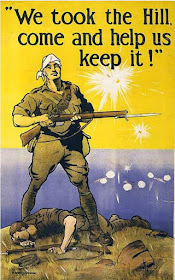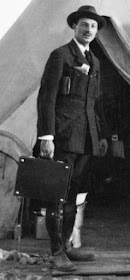Oh dear, how wrong can the
overnight typewriter “experts” be? How many more times are we going to have to
set the QWERTY record straight before some of them can start to grasp the
truth?
Never
before in one single week has some much rubbish been written and published
about the origins of QWERTY.
OK,
let’s start with Wednesday’s pile of nonsense headed “How did the qwerty
keyboard become so popular?” by Tim Harford of the BBC World Service.
1.
“The father of the qwerty keyboard was Christopher Latham Sholes, a printer
from Wisconsin who sold his first typewriter in 1868 to Porter's Telegraph
College, Chicago. That bit's important.”
WRONG:
In the summer of 1868 James Densmore, Samuel Willard Soulé and Edward Payson Porter
had machines made in Chicago which Porter tested with students at his school
for telegraphers. None were "sold" and Sholes had no direct involvement in the exercise. The
machines used bore only a passing resemblance to the typewriter we know today
as the Sholes & Glidden, and were little more than early prototypes of the
typewriter.
2.
“The qwerty layout was designed for the convenience of telegraph operators
transcribing Morse code …”
WRONG:
The first machines employing the QWERTY configuration were sold to a variety of
people, including Chicago detective Allan Pinkerton, Wisconsin attorneys the
Dawes Brothers and stenographers Walter Jay Barron and James Ogilvie Clephane,
the latter using them for his commercial typing service. They were not
specifically designed to be used by telegraph operators, although some were.
3.
“It wasn't the only typewriter around …”
WRONG:
Discounting the still then little known Hansen Writing Ball, the Sholes & Glidden/Remington was on its own until 1881.
Now
let’s look at the next heap of misguided codswallop, “The truth about the
QWERTY keyboard” by Graham Lawton, which appeared yesterday in – of all places
– the New Scientist!
1.
“Why are we stuck with the QWERTY keyboard? The history of the most commonly
used keyboard layout is a sometimes murky story of commercial opportunism,
critics with ulterior motives and the stubborn persistence of an idea that's
seen off hundreds of supposedly superior competitors.”
WRONG:
There is absolutely nothing murky about the story of QWERTY, it’s a clear as
crystal. There was no commercial opportunism involved (there were no rivals at
the time). QWERTY has seen off just two semi-serious challengers,
Blickensderfer’s Scientific and Dvorak - two, not hundreds.
2.
“What happened next is a little murky … almost out of the blue, QWERTY (almost)
appeared. In August 1872 Scientific
American published a glowing article about the “‘Sholes’ Type Writer”,
illustrated with an engraving of the machine showing a four-row keyboard with a
second row starting QWE.TY [my italics].”
WRONG: There is nothing murky about it. Sholes and
Densmore settled on the QWERTY configuration on Thursday, November 7, 1872.
Densmore was the first to test it, in the early hours of the next morning,
writing two letters to his stepson Barron. Scientific
American of August 10, 1872, DID
NOT show a keyboard layout, with QWE.TY or any other
combination. QWE.TY is a configuration which appeared on a February 1873 "axle machine" prototype. As such is it irrelevant to the QWERTY story, as QWERTY had already been settled on four months earlier. Regardless, this "axle machine" was not patented until 1878.
3.
“Remington put its No 1 Type Writer on to the market in 1874 …”
WRONG:
The Sholes & Glidden was marketed in 1874, the Remington No 1 came out the
next year.
A
lot of this balderdash has been picked up and repeated from an article by Trevor English published last June. “The story of how the modern keyboard came
to be involves Morse code, marketing, and a little bit of luck.”
“Back
in the 1860s, a man named Christopher Latham Sholes was busy developing ways to
make offices more efficient. Notably, he spent his time developing all
different kinds of typewriters (!) and key layouts to improve how people wrote
and communicated. Working with others in the field, he patented the first
typewriter in 1867. Previous to this invention, there were other machines used
for writing, but none were standard (?) … After working continuously to come up
with new designs, in 1873 Sholes landed on one that had a similar layout to the
modern QWERTY, but with a few keys switched. It would've been known as the
QWE.TY …”
Where
this idea of QWE.TY appearing in Scientific
American in August 1872 comes from I have no idea. Even Scientific American more lately has
mentioned it – maybe the magazine ought to check this out have a look at its
own back issues? QWE.TY only ever appears on an 1873 prototype. How can anyone get so confused?
“Right
after Sholes and his partner Carlos Glidden patented the QWERTY design …”
Sholes alone took out the 1878 patent which showed the QWERTY configuration.
It
seems most of this poppycock started back in January 2012 with a “Today I Found
Out’ article called “The Origin of the QWERTY keyboard” by someone called
Samantha. “The first typewriter was introduced to the United States in 1868 by
Christopher Latham Sholes ... In 1868, in collaboration with educator Amos
Densmore, Sholes arranged the letters on the keyboard for better spacing
between popular keys used in combination.”
Well,
just how many times can I write WRONG? Amos Densmore could be described, at
best, as a businessman, the educator was Alexander Davidson, and Davidson
worked on the Caligraph, not the Sholes & Glidden. What’s more, QWERTY was
FIRST settled on in November 1872. “The first typewriter machine found its way
on the market in 1874 through Remington & Sons. The device was called the
Remington No 1.” No it wasn’t. It was called the Sholes & Glidden.
No
wonder there’s so much fake news around when people can’t even get a few simple
facts right. Anyone wanting to find out the real story behind QWERTY, and the
Sholes & Glidden itself, should take the time and make the effort to read
Richard Nelson Current’s The Typewriter
and The Men Who Made It (first published 1954, republished 1988). It’s all
there, in plain black and white. Or is picking up a real, tangible book,
reading it and taking in what it says just too much bother these days? And the Scientific American of August 10, 1872, is readily available online, if anyone cares to have a look:


























































